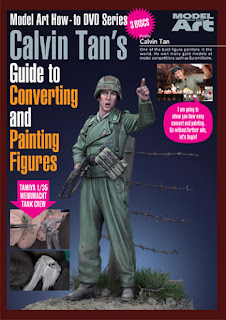Alpine Miniatures - III/SS-PzGren-Rgt 2, Ardennes, 1944
_
After a fruitful weekend of painting, here are some test shots of Sturmbannführer Josef Diefenthal and an accompanying NCO (no doubt modeled from the SS-Rottenführer with the MP-44 of KG Hansen at the ambush at Poteau) slated for release by Alpine Miniatures sometime soon.
Just to clear the air about Diefenthal's attire,it was brought to my attention before the commencement of this assignment by one of the co-authors of Duel in The Midst, Roddy Mcdougal l- from credible veteran accounts and close studies of war-time photos - Diefenthal was in fact wearing the Italian camouflage trousers at that time instead of the purported Oak-Leaf camouflage trousers.
With regards to color notes, I would like to mention that the choice of my color palette was steered by the principals of color usage of the Impressionists. Though I did not employ the same color mixes but should you prefer an "accurate" and less complicated guide may I recommend the following:
On the topic of painting principals, the Impressionists strongly believed that the shadow is not the absence of light but rather light of a different quality and value. Often so black/brown has always been used a convenient color to accentuate contrast with any subordinate color. The result is often stark, flat and lifeless. Not a bad thing for depicting conditions of war but what I am attempting to explore here is an alternative. Remember the Raw Umber wash technique to "shade" all colors fair and dull? Yes, it does create shades but in the process it also dulls and corrupts the color; especially the fair ones. Most of us including myself can get away by using dirt to generate shades but that however is not the only solution to create tonal contrast on a miniature space.
With this assignment, I attempted to enhance the dimension of the color field by substituting black for dark blues and violets in the shadows. This produces a much more natural appearance of shadows instead of just solid tones of black and brown. The key note about color is that its appearance is relative. Means to say that by itself against a white background it appears obviously violet but when juxtaposed against or over others and at a certain distance is perceived a dark value instead.
Using this technique of Broken Color as written by Camille Mauclair "produce upon the eye of the beholder the effect of actual colouring of the things painted, with a variety, a freshness and a delicacy of analysis unobtainable by single tone prepared and mixed upon the palette."
This is the main reason why I abstained from using colors straight from the bottle but instead mixed the shades and tones using primary and secondary color sources such as Park Green and Magenta. By varying the proportion of these component colors, one could generate more spectacular alternatives of tones and shades of Field Grey.
Complimentary color schemes are observed with the red-bias magenta for shadows and green-bias field grey as highlights. For the tunic and several parts, there are violet-bias for the shadows and yellow-bias for the highlights. In summary, I'm not creating dirt/soot effects but rather painting light to depict atmosphere to yield a more emotive and compelling result. Next week perhaps I shall continue to delve more into these principals to paint the 1/16 SS-Grenadier.
cheers,
Calvin



















11 comments:
wow thats very informative.
thank you for this explainaition.
great painting and atmosphere!
I would be interested in which techniques you keep using from your book and which techniques you changed:)
best regards
Andreas
Hi Andreas,
the none of the techiniques have changed only the concept of approach.
Calvin
Great work as usual Calvin .correct me if i'm wrong but did you mix the Field Gray from Park Green ,Magenta,and if any what shade did you use for a highlight .
Also what color or colors did you use for the shading of the camouflage
Your work just simply amazes, always evolvoning with different color variants. I hope to one day get even close to the results you show on your blog and with all of your figures. Great job, can't wait to buy these!!!!
Hi Doug,
the base color field grey was mixed from Magenta and Park Green. As this produces a very dark color I proceeded to lighten the hue by mixing varying proportions of Pastel Blue to achieve a cool tone.
The camouflage tunic was shaded with purple and dark blue.
Calvin
Hi Calvin.
Great painting as usual!!!@.@
I guess your painting style is some different and better than before.
Thank you very much for sharing:)
All my best regards,
MJ,Kim.
P.S : I forgot to say this words for your princess, "She is your best work of art in your life!!!Congratulations!!! :-)"
Hi Calvin, my name is Burak Ayağ and i am from Turkey. I'm a new figure modeller and i so like your figures. This Ardennes figures is really great.
I got something important when I do blending work with acryl. Thanks a lot!
Mr. Tan, I'm Josep Maria from Barcelona. Congratulations for all your works.
Very nice work. Greets from Germany of the Militär Modellbau Netzwerk
Hi!
Park Green is the base color ?
Post a Comment